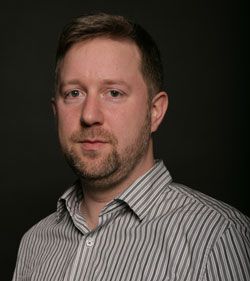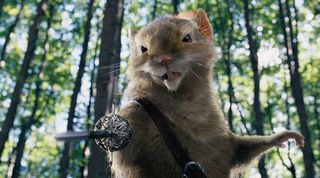This article is brought to you in association with Masters of CG, a new competition that offers the chance to work with one of 2000AD's most iconic characters. There are big prizes to be won, so enter today!

MPC (Moving Picture Company) is one of biggest names in VFX in the world today. The lead studio for Godzilla - for which it created all the creatures - the company has also been recently working on Maleficent, X-Men: Days of Future Past, Guardians of the Galaxy, The Amazing Spiderman 2, Game of Thrones S4, and plenty more besides.
So it's fair to say that when it comes to visual effects, there's no hotter place to be today than MPC - and only the most exceptional artists stand any chance of working there. But it's not always been like this, says Greg Butler, VFX Supervisor/Head of VFX for the company's Vancouver studio.
Intern at ILM
"When I started as an intern in 1992, the industry was very small and mysterious," he recalls. "There were no visual effects schools and only a few computer animation and computer science programs. People usually got into the industry by knowing someone already in it.
"Companies like ILM and Boss Film didn't even have published addresses or phone numbers, and there was no internet to help apply for jobs."
It was in this pioneering and somewhat chaotic atmsophere that Butler got an early introduction to large-scale CG production as an intern at ILM. Later he joined a small team at Tippett Studios as they transitioned from a traditional stop-motion creature shop to large-scale projects, creating the bugs for the much-loved modern B-movie Starship Troopers.
Making magic
Next came six years in New Zealand working with Weta Digital, where he helped build their Creature Department and oversaw VFX sequences across the Lord of the Rings trilogy and I, Robot as CG Supervisor. Then in 2005, he joined MPC London as VFX supervisor, leading teams on movies including The Chronicles of Narnia: Prince Caspian, Harry Potter and the Order of the Phoenix and GI Joe: The Rise of The Cobra.
Get top Black Friday deals sent straight to your inbox: Sign up now!
We curate the best offers on creative kit and give our expert recommendations to save you time this Black Friday. Upgrade your setup for less with Creative Bloq.
It's an incredible body of work that includes such classic scenes as the confrontation between Voldemort and Dumbledore in the Ministry of Magic during Harry Potter and the Order of the Phoenix. "I'd only been at MPC London for a year when we started work on that sequence," Butler recalls. "It's one of the most dramatic moments in the Harry Potter books and we wanted the film to be just as exciting and memorable.

"The MPC crew built a digital version of the Ministry of Magic atrium and filled it with wand dueling and magical fire. I'm very happy with how our work turned out and really enjoyed the process of putting it together. We had such a talented team on that show; at least five of them are now visual effects supervisors themselves."
Another scene close to Butler's heart was a shot known as 422_41, where Gollum wakes up in The Lord of the Rings: The Return of the King. "It's one of the last shots I did as a lighting TD when I worked with Weta," he explains. "I'd spent years working on Gollum and it was the perfect shot to finish with. I used four lights and spent a long time placing them to get a nice shape and realistic skin texture."
The subtler stuff
But visual effects isn't just about big fantasy blockbusters. MPC also does a lot of work on movies that are less obviously 'about' visual effects, such as The Monuments Men, a 2014 American-German drama directed by George Clooney about saving important artworks from the Nazis. Here, the challenge is to make the effects 'invisible', Butler explains.
"The audience can't be allowed to notice the visual effects or it will get in the way of the story. You're often creating images that are very familiar and viewers will sense if something isn't right.
"In contrast, on visual effects-driven films, the audience already expects to see things they've never seen before. There has to be a level of realism maintained so that suspension of disbelief exists, but the work is judged more on how 'cool', innovative and exciting it is."

"Both types of work can be extremely challenging, but in different ways," he adds. "At MPC we pride ourselves on photorealism and detail, and have a large compositing team who help us get the best looking shots possible."
Stereoscopic challenge
Butler's career has spanned an era in which stereoscopic 3D has moved from gimmick to a central part of filmmaking. MPC has played a central role in this new trend, delivering stereo work in movies including Prometheus, Pirates of the Caribbean and Life of Pi. And it's by no means easy to get it right, Butler stresses.
"All of the 'plates' shot in stereo need to treated to get the hero eye image to match the other (left is usually hero)," he explains. "Plate-based work, such as camera tracking and roto, takes longer and have to be even more accurate.
"Many tried and true compositing techniques are not usable in 3D stereo. More passes of QC are required and there is a very low tolerance for even small errors. Stereo viewing can make small mistakes quite distracting for the the audience, so attention to detail is important."

Complicating things further, there are essentially two types of stereo 3D: native (where the movie is shot with two cameras) and dimensionalised (where 2D shots are converted to stereo in post production).
"Native stereo is more challenging, mainly because almost all dimensionalisation happens after our work is done," Butler says. "We can use a broader range of techniques and complete shots in mono. We still have to be aware of the stereo process, but not make it part of our shot pipeline."
Future challenges
Technology never stands still, and Butler expects it to continue to throw further challenges MPC's way over the next few years. But as to which tech will end up dominating, he can only guess.
"The biggest changes will be guided by our audiences," he points out. "Are people going to want to watch 4K television (UHD), high frame rates, 3D stereo? How will films, television, video games and other types of content evolve or merge? What kinds of films will be popular and how will visual effects lead or follow directors' ideas?"
The secret to survival in such an uncertain environment is to stay nimble, he says. "It's been many years since visual effects became a global business and I think that's a permanent change. However, at MPC we know that value comes from openness to change, from a culture of innovation that embraces the future. I do think there is still a lot of change to come in how people collaborate with each other remotely.

"Technology makes this way of working possible, but human nature still prefers direct interaction. I think this will change as more and more people grow up in a social media world."
How to manage artists
Meeting all of these present and future challenges depend on artists working together closely, and as VFX Supervisor, it's Butler's job to manage and motivate his team to get the very best work out of them. So what advice does he have anyone wishing to do the same?
"Don't get stuck in the details," Butler recommends. "Make sure everyone is clear on what the short and long term goals are and where they fit into the big picture. Delegate, motivate and empower individuals to bring the best out of everyone."
At a large house like MPC, it's largely about trust, he adds. "Even our small projects usually have a few hundred shots. At that scale, you have to rely on people knowing their jobs and working to a valid schedule. Show schedules are constantly being updated as changes on a project never stop. MPC has spent years developing tools and techniques for production management so our artists are free to do what they do best."
Advice for young people
And for those just starting out in their careers, he has this advice to offer. "Market yourself on your strongest skills, but look for opportunities to broaden your range so you can adapt to changes in the industry. Stay on top of trends in software and techniques. Get to know the people around you, in all areas and at all levels. Become known as a 'go-to' person who delivers results."
And while you may think you're being ignored, your work and attitude probably isn't going unnoticed, he adds.
"As a manager and supervisor, I notice when an artist is talented and does a job really well and I'd assume they will do the same if given more responsibility. We want our artists to thrive on being part of the process, to feel free to contribute ideas and make mistakes, to give and take constructive feedback."
Win a trip to SIGGRAPH!

Masters of CG is an exciting new competition for EU residents that offers you the one-in-a-lifetime chance to work with one of 2000AD's most iconic characters: Rogue Trooper.
We invite you to form a team (of up to four participants) and tackle as many of our four categories as you wish - Title Sequence, Main Shots, Film Poster or Idents. For full details of how to enter and to get your Competition Information Pack, head to the Masters of CG website now.
Enter the competition today!

Thank you for reading 5 articles this month* Join now for unlimited access
Enjoy your first month for just £1 / $1 / €1
*Read 5 free articles per month without a subscription

Join now for unlimited access
Try first month for just £1 / $1 / €1
Tom May is an award-winning journalist and editor specialising in design, photography and technology. Author of the Amazon #1 bestseller Great TED Talks: Creativity, published by Pavilion Books, Tom was previously editor of Professional Photography magazine, associate editor at Creative Bloq, and deputy editor at net magazine. Today, he is a regular contributor to Creative Bloq and its sister sites Digital Camera World, T3.com and Tech Radar. He also writes for Creative Boom and works on content marketing projects.




